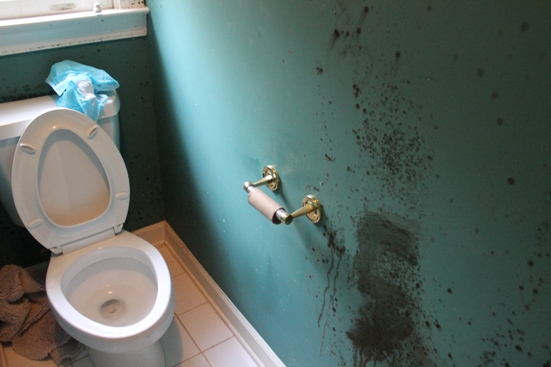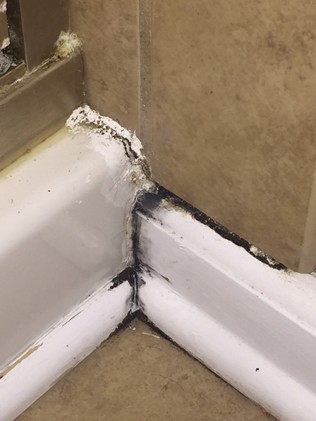Find a Mold Specialist Now
Click or Call, Toll-Free 24/7
Bathroom Mold Prevention
Outside of our kitchens, our bathrooms may be the most used, and essential, rooms in our home and require detailed care for effective bathroom mold prevention. Most bathrooms contain no windows, therefore they receive little or no natural light. Most of the time that someone is in the bathroom there is water running (bathing, showering, hand washing, brushing teeth, etc). Most of the time the door is kept closed and because it’s a smaller sized room it usually remains slightly warmer than the other rooms in the home. For the most part, our bathrooms can be one of the wettest rooms in a home. Put all these factors together and you have a small, dark space with higher than normal humidity levels. Just the right conditions in which to develop bathroom mold!
Allowing mold to grow in your bathroom will not only impact the overall appearance of the bathroom, it could cause damage to walls, floors, ceiling, or ceramic tile. Literally, your floor and ceiling could begin to sag, and ceramic tiles could begin to fall off the walls. Grout can begin to darken due to mold staining. Bathroom mold prevention is essential to maintaining a safe, healthy bathroom.
Cleaning Steps For Bathroom Mold Prevention
1. Dust your bathroom at least every week. Dust contains multitudes of organic matter. Items like soil, plant pollen, human and animal hairs, textile fibers, paper fibers, and human skin particles can be found in dust. Mold, just like us humans, needs food to survive. By leaving less “food” lying around, you help to “starve” any mold. And remember, when dusting, start up high and work your way down towards the floor.
2. Use an all-purpose bathroom cleaner. Wipe down ceramic tile around your bathtub and/or shower, the tub itself, your sink bowls and countertops, and your toilet. Do this on at least a weekly basis. This will help further eliminate leftover organic materials and possibly any mold spores that may have settled in between cleanings.
3. Clean bathroom mirrors and windows. Start by placing some rubbing alcohol on a cotton pad. The alcohol will help remove things like hairspray and toothpaste splatters. Act quickly, because alcohol will dry fast. After misting the mirror with the cleaner, use a soft, flat-weave microfiber cloth to wipe down the mirror. Don’t use a newspaper (grandma’s old-fashion way) or a paper towel (paper towels tend to leave small pieces of lint behind).
4. Wash shower curtain liners and any bathroom throw rugs often. Believe it or not, plastic shower curtain liners can be washed in your washing machine. Just add the liner in with a load of whites and add a handful of baking soda. The baking soda will help cut odors, boost the power of your laundry detergent, and help clean the washing machine itself. Throw rugs should be washed in cold water and then dried on the lowest heat setting in your dryer.
5. Keep damp bathroom towels hung up. One of the worst things you can do in the bathroom is to leave damp towels lying in a pile on the floor or hung over the shower curtain. Doing so will contribute to a moist, humid environment which may encourage mold growth. Although towel hooks are fine, a towel rod is better as it allows the towels to be spread out and dry at a faster rate.
Eliminate Excess Moisture For Bathroom Mold Prevention
1. Leaky faucets and pipe connections need to be fixed. Any drips and small leaks need to be repaired as soon as they are found. They cost you extra money on water bills and add moisture to an already humid environment. Remember, mold loves water, so don’t conveniently provide it.
2. Don’t store bathing products in your bathtub or shower. Sponges, washcloths, shampoo bottles, and bath toys may give mold spores a place to hide. Instead of leaving these wet or damp items in the tub, dry them off or wring them out and store them in a dry space until they are to be used again.
3. Dry down tub surrounds and ceramic tile after bathing. After doing everything possible to prevent bathroom mold, why would you leave the walls of your shower or tub wet? Wiping down the shower or tub walls will remove excess water and help keep these areas clean longer.
4. Always turn on your bathroom exhaust fan. Run it while you are bathing and then leave it running for a short period of time after you’re finished.
***A word of caution: never leave any exhaust fan running and leave the house. The fan motors tend to freeze up when left running too long and sparks can ignite lint or dust in the fan. Many house fires are reported each year because someone left their exhaust fan running while they were not at home.
5. Leave the shower curtain or shower door open. Leaving these open allows for better airflow, which promotes quicker evaporation and drying.
6. Seal tile grout lines yearly. By sealing or resealing ceramic tile grout lines on at least a yearly basis, you can help eliminate water from penetrating through the grout and under your ceramic flooring. To test whether your grout needs to be resealed, you can place a few drops of water on the grout in different areas. If the water soaks into the grout, it is time to reseal. If the water drops bead up, your grout requires no resealing. Before resealing, clean the grout lines using a pH-neutral cleaner. PH-neutral cleaners are the most gentle type of cleaners. They are safe to use on all types of grout and do not have to be effectively rinsed off before applying a sealer. Household detergents, on the other hand, are harder to completely rinse off and remove from grout surfaces.
7. Leave the light on. Another great idea is to leave a bathroom light on for 24 hours, once a month. Mold likes moist environments, but it also likes a dark area or room. Leaving the light on is not welcoming to mold.
Qualified Professional Help
Bathroom mold prevention starts with you. Follow the procedures above and bathroom mold may never become an issue. If you do see bathroom mold, there are recommended mold removal professionals, just a few clicks away, who can assist you in its removal. They will provide a free inspection and recommendation for the mold’s removal.
Return From Bathroom Mold Prevention To Our Main Mold Prevention Page
Black Mold Health Symptoms Home Page






